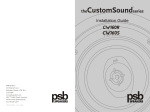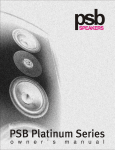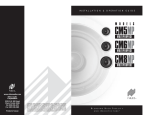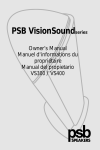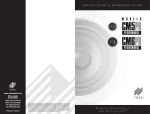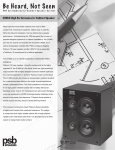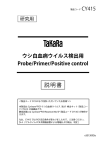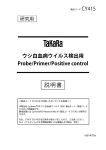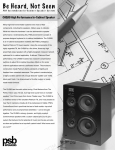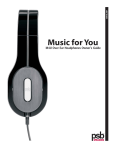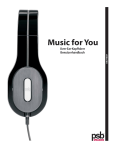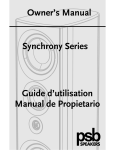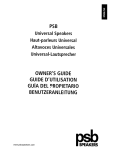Download CW600E_CW800E_Owners_manual_weee_English
Transcript
the CustomSoundseries Owner’s Manual CW800E CW600E CWS10 CONTENTS I. Warranty Registration II. Unpacking III. Materials and Tools A. Required Tools B. Other Tools IV. Speaker Placement A. Listening Locations B. Speaker Locations C. You in Relation to the Speakers D. You in Relation to the Room Boundries E. Positioning Surround Speakers F. Positioning Subwoofers V. System & Supply VI. Obstructions VII. Installation VIII. Connections IX. Wiring A. Rough-In Wiring B. Conventional Wiring C. Tricks of the Trade X. Grilles A. Installing & Removing B. Grille Alternatives XI. Painting A. Construction Dust and Paint Shield B. Painting Finish Frames C. Painting Grilles XII. Set-up A. High & Mid Frequency Switches B. Listening—Balance, Range and Imaging C. Recommended Power XIII. Protecting Your Investment XIV. In Case of Problems XV. Specifications 2 Congratulations on choosing PSB CustomSound Series speakers. Please take the time to read the instructions in this guide, as they will help you enjoy the full potential of your loudspeakers in any stereo or multichannel home theater application. I. WARRANTY REGISTRATION We recommend you take a few moments now to register your warranty, preferably on-line at psbspeakers.com/w/Warranty.html or via the enclosed registration form so that we will be able to serve you better in the future. II. UNPACKING The packing materials of your PSB speakers are designed to protect them from damage during shipping. Retain the packaging in case the need arises to transport the speakers in the future. III. MATERIALS AND TOOLS The only other materials necessary to install CustomSound speakers are paint and extra fine sandpaper if you wish to change the color of Grills and/or Finish Frames from their standard white. Of course, wire cable of appropriate length and size will be necessary to connect speakers to amplifiers (or volume controls) in the music system. A. Required Tools The following tools are needed for normal, simple installations: Tape Measure, Pencil, and Level Utility Knife and Wallboard Saw (and extra blades) Philips Screwdriver and Putty Knife Drill and Bits (smaller for lead holes and larger for cabling) Probe Wire (a heavy coat hanger can substitute for a short fish-tape) Flashlight B. Other Tools Particularly when installing a quantity of speakers, or installing in wood paneling or other wall materials, the following tools are desirable for neater and more efficient installations: Stud Finder (helpful—particularly with simple, wallboard-on-studs construction) Metal Straight Edge (Ruler or Framing Square) and Masking Tape Wallboard Rasp/Sanding Block (or a piece of wire lath around a block) Awl or Worn Screwdriver (for initial, exploratory holes) and Hammer Wire Cutters/Strippers and Electrical Tape Battery Screwdriver and Power Drill and Extensions (with extra bits) Jig Saw and Blades Wallboard Router and Cutout Bits 3 IV. SPEAKER PLACEMENT — MAXIMIZING YOUR ENJOYMENT Proper loudspeaker placement is an essential ingredient to getting the best sound from your high performance stereo, multi-channel audio or home theater system. The goal is to reproduce faithfully the audio soundtrack the movie director or music producer created without calling any attention to the speakers themselves. A. Listening Locations Consider the desired, intended, and probable locations of listeners when considering speaker locations. Ideally, listeners should have a clear line-ofsight/hearing to all speakers in their listening area—not too far off axis and not obstructed by structure or furnishings—for most balanced frequency response. Where will listeners be—primary and secondary? Where will listeners’ ears be—sitting, standing, walking? No installation is absolutely ideal, but considering listener locations with speaker location can greatly improve the final result—and simplify the effort and expense to achieve it. B. Speaker Locations Here are three simple ideals, which are never fully satisfied: 1. Locate speakers equidistant to listeners, preferably at ear level. 2. Locate speakers closer to each other than their distance from listeners. 3. Locate speakers symmetrically to each other and to their physical surroundings. Ideally, listeners will be equidistant from front right and left and center channel speakers and from rear (or side) left and right surround channels for most accurate spatial imaging. If listeners are too close to front or to rear channel speakers the image cannot come together and flow seamlessly across. While ear-level mounting is ideal, the swivel tweeters can be aimed towards the listeners, increasing the accuracy of frequency response when speakers are located further off axis from listeners’ ears. Most importantly, a center channel speaker should be located centered on the TV screen—to keep center channel sound coming from the center of the screen. 30° 30° 30° 4 30° Balance adjustment can compensate for some physical location difference between left and right. Time-delay adjustment of surround sound can compensate for some physical location difference between front and rear. With mono signals equidistant, symmetrical location is still desired to minimize balancing requirements. Proximity to additional side wall, ceiling or floor surfaces will cause increases and decreases in frequency response which are very difficult to electronically equalize for smooth response overall—particularly when only some of the speakers are affected. All CustomSound models are designed to maintain the same tonal balance when different models are mixed in a system. The same model should be used in symmetrical listening locations in a system—front left and front right; rear left and rear right. Each CustomSound speaker carton contains a full-size template of the front of the speaker. These templates can be used when initially locating speakers and then when marking and cutting out speaker locations. We encourage temporarily taping templates in the intended locations and then sitting in the primary listening location and considering the above guidelines again—also realizing that behindthe-wall conflicts will probably require some adjustment to the intended locations before they are final. C. You in Relation to the Speakers Where you sit in relation to your speakers obviously makes a difference too. The proportions of the particular triangle formed by your front left and front right speakers and you matter. (You may need to send more power to the more distant speaker to compensate if you get much further from one speaker than the other.) The overall distances involved also matter. As you get further from the speakers, more sound reflected from your room’s surfaces (in contrast to the sound coming directly from the speakers) reaches your ears, and the original spatial relationships in a recording are changed as your room “takes over.” Sometimes the result is a mellower, more “integrated” sound. Other times, it’s a more strident or annoyingly “echoey”—or other—quality. Once again, the particular dimensions and surface materials of your room play a part. And depending on what seems more realistic and/or enjoyable to your ears, you may choose to sit at a great distance or have close-up, “near-field” sound. D. You in Relation to Room Boundaries Changing your own position with respect to a room’s boundaries may also bring a big effect, sometimes for a small change. Getting further from the wall behind you may make sound more precise and localized. Getting closer may make sound more “mellow” and integrated. Coming too close—to back wall, side wall, or (especially) a corner— you may experience a major peak or cancellation of a certain band of frequencies. It depends on factors we can’t cover fully here but do get into on our web site. As you consider the three relationships we have outlined, the idea is to manipulate whatever variable is easiest and most productive for improving your listening experience. Be sure to base your judgements on listening to a good variety of recordings of vocals, and acoustic instruments, soloists, different movies and musical instruments to most easily recognize tonal balance shifts. 5 E. Positioning Surround Speakers All PSB CustomSound Series speakers including the CW800E and CW600E are timbre matched (have similar tonal characteristics) for easy mix and match home theater system flexibility and ultimate performance. Most surround sound (that is sound that comes from the surround speakers, not the front speakers) is meant more to create greater depth and overall ambience than to localize effects as coming from a particular spot. How much you prefer these localized effects vs. overall sonic depth and diffusion is up to your listening preferences. If you are listening to multi-channel music from DVD-Audio or SACD, you may want the maximum localization of instruments. However, for most home theater applications a diffuse soundfield might be preferred. You can locate your surround speakers to produce the effects you prefer, whether precisely pinpointed or pleasantly diffused. Most people find it best to mount surround speakers on the side walls slightly behind the prime listening position and two feet above ear height when seated (this typically places the top of the speaker near the ceiling.) Note, that as you move from Figure 1 through to Figure 3, the surround effect will become more diffuse and more evenly spread. 30° 30° 30° 30° 30° 30° All distances are equal Figure 1 6.1/7.1 System using two Surrounds Figure 2 6.1/7.1 System using three Surrounds Figure 3 6.1/7.1 System using four Surrounds F. Positioning Subwoofers The location of subwoofers will interact with the dimensions of the room to determine the low frequency response of the overall system. Unlike with a free standing subwoofer the CWS10 in-wall subwoofer can't be mounted away from the wall surfaces! The key question is where on the wall should they best be located. Generally the CW600 or 800 should be located first by following the guidelines for placement (above) with regard to angles around the listener. Their location is more critical than the location of the subwoofers. Once the main front speakers are located then you may want to mount the CWS10(s) in a spot that visually looks appropriate relative to the front speakers. This might be in the same stud bay but directly below the front left or right. Alternatively they may be mounted at just the same height as the other front speaker, yet outside them and more towards the corners. Either approach is generally acceptable. Be aware that mounting the CWS10 closer to a corner will generally increase the overall bass level and that will increase its output capability, a good thing. 6 Avoid mounting the subwoofers at the rear of the room or on the side walls far from the front wall. Although our sense of location for very low frequencies is poor it will still degrade the blend between bass and upper frequencies when the subwoofer and the front speakers are mounted far apart. An exception to this is when one subwoofer is mounted in the center of the front wall and a second subwoofer is mounted in the center of the rear wall. Recent studies have shown such a technique to generally give a very good low frequency room response. V. SYSTEM AND SUPPLY Overall, a musical source—audio or video—is fed first through a preamplifier with switching and tone controls—and then through a power amplifier and onwards to each speaker. The preamplifier provides a variety of controls—bass, treble, and balance left to right. Surround processors, operating between the preamplifier and amplifier stages, can provide surround decoding and another level of channel balancing—front left, right, and center; surround left and right; and subwoofer. An equalizer before the amplifier can provide some adjustment to smooth response for field conditions and preferences. Multiple amplifiers may be used for multiple zones and speaker loads. VI. OBSTRUCTIONS With tentative speaker locations determined, potential obstructions must be explored and the conflicts resolved: Structural; Mechanical—Electrical, Plumbing, and HVAC; and Furnishings. Note: The CW800E and CW600E have a large enclosure and must have a full (16” center) unobstructed stud bay with no other wiring or plumbing. Temporarily mark and view tentative speaker locations and the existing construction carefully to determine the existing structure and mechanical installations and potential obstructions. Adjust the speaker layout, the furnishings, the mechanical, and/or the structural to resolve the conflicts. Layout, review, and resolution on building plans can be a very efficient process. However, some conflicts will inevitably appear and need to be resolved as actual conditions are reviewed and as installation proceeds. Most typically, residential walls are constructed of wooden studs—nominally 2" x 4", but measuring 1½” x 3½" (sometimes, particularly on exterior walls 2" x 6", measuring 1½" x 5½") and normally located on 16" centers—with 14½" between studs. This stud pattern usually begins from one, exterior corner and results in a smaller than normal spacing at the other corner. The full height "common" studs extend from a flat "sole" plate on the floor to a "top" plate (often doubled) at the top of the wall. Top headers of doubled 2" x 4"s (or larger) are placed on edge spanning over doorways and windows, and doubled sill headers run under window openings. "Trimmer/jack" partial studs run under the ends of all headers, doubled against full studs against the ends of all headers. Shorter partial "cripple" studs run over headers to the top plate and under sills to the bottom plate—at nominal spacing. Blocking may be between studs about mid-wall, behind cabinets and other fixtures mounted to the wall, and over and under ductwork through the stud cavity. Electrical receptacles and switches are mounted in electrical boxes, usually mounted to a stud. Removing electrical cover plates in finished walls is a good initial step to determine where studs are located. Floors typically are constructed of wooden joists—nominally 2" x 8" or deeper, but measuring 1½" x 7¼" or deeper and normally located on 16" centers (but not 7 uncommonly on 12" centers). Roofs typically are constructed of wooden rafters—nominally 2" x 6" or deeper, but measuring 1½" x 5½” and located on 16" centers (but not uncommonly on 24" centers). Ceilings are usually backed by 1" x 3" strapping leveled beneath the floor joists or roof rafters and located on 16" centers. Electrical cables run to, and most often from, all electrical boxes—which are grouped on circuits. Plumbing supply, drain and vent lines run to and from all plumbing fixtures—which are grouped on vertical risers. Heating supply lines circulate through radiation fixtures—which are grouped in zones off vertical risers. HVAC ductwork runs to all supply grills and from all return grills. Control wiring (sometimes tubing) runs to all controls. Corner bay locations should be avoided since at least one corner bay is usually smaller than normal, hence the speaker will not fit, and closeness to the side wall will cause some unevenness in frequency response. Electrical power wiring should not run close to the speaker or it's audio supply; crossing away from the speaker and its supply has minimal effect. Tricks of the Trades—Nothing's Plumb, Square, or True All people in construction realize that it is an exacting but inexact craft—nothing is exactly, absolutely plumb, square, or true. The craft is to understand and respect the tolerances of materials, tools, makers, and users—what will look right to the eye, is reasonably possible to build, and will retain it's position over years—within the budgets of money and time. Planning, measuring, and coordinating are important; but conflicts, tradeoffs, and imperfections are inevitable in the final construction. Pre-construction drawings are very valuable to further the process mentally before the physical begins. Post-construction, asbuilt drawings are valuable to assure performance and aid modification. However; no drawings will be entirely complete or consistent with the construction. Proceed with an open and responsive mind. Prepare to be surprised, challenged, and rewarded—to solve the many small riddles along the path to completion. VII. INSTALLATION These speakers use a particularly effective mounting technique with toggle style mounting clamps. They are so named because the mounting clamp toggles out from a rest position prior to tightening down. As shipped, this mounting clamp parks on a flat on its mounting tower, thus staying out of the way for easy insertion of the system into the wall cutout. When a screwdriver is applied to the mounting screws it first turns the clamp 90 degrees, removing it from its resting place, and then brings the clamp down a track in the tower. With further tightening it finally clamps the wall firmly. This clamping style gives firm clamping for freedom from rattles, and great convenience of installation. The CW800E has 16 of these clamping assemblies. The CW600E has 12. A template is provided for marking the speaker cutout. It has a series of slots for tracing the cutout and also an outline of the system to confirm that the flange won't interfere with any wall features. At each intended speaker location measure and mark with a pencil the intended center of the speaker. Near the intended center make a small initial exploratory hole with an awl or (worn) screwdriver and hammer, a wallboard cutout saw, or a 8 drill. If the awl, screwdriver or saw hits "solid" after the wallboard or plaster is pierced or if the drill produces sawdust after the initial wallboard/plaster dust, you have probably hit a wooden stud—which will obstruct that location. If drilling becomes harder after piercing the wallboard or plaster, remember it could be plumbing, mechanical, or electrical material. If you feel unusual resistance or sense an obstruction, stop. Consider the situation and carefully make another small exploratory hole about 1 1/2" to the side where you would prefer the speaker location to move. When your small exploratory hole avoids obvious obstruction, enlarge that hole slightly with the screwdriver and hammer (or wallboard saw) until you can extend a short probe wire/fish-tape through the hole and determine the location of the stud on each side and other obstructions. Adjust your layout if necessary and then enlarge the hole slightly so that you can see into the wall cavity (aided by a flashlight) and confirm there are no further obstructions. Continue this process of initial layout, exploratory holes, determining hole, and confirming hole at each intended location in a related group before proceeding with full cutouts. You can then modify the initial layout as required to avoid the inevitable discovered conflicts and maintain a desired layout for acoustical performance and visual aesthetics—while avoiding and minimizing any excess cutting and patching. Cut a hole large enough to see left and right stud locations. Center the template on the wall based on those locations. The cutout will have to be well centered between the wall studs. There isn’t enough space between the studs to allow any side shift. Now cut out the full rough-opening being careful to avoid over-cutting, breaking edges of the opening, or damaging surrounding paint or wallpaper finishes. A wallboard handsaw, preferably with replaceable blades, is the normal tool. Powered drywall cutters can also be used if you are careful to cut in a straight line or if you use a guide. The Finish Frames are about 3/4" wide around the Grilles on the finish surface and extend about 5/8” beyond the rough opening cutout, which should be quite adequate cover with reasonable care in layout and cutout. Check that openings are large enough and plumb by test fitting the speaker into the opening. A wallboard rasp block/plane is very useful to slightly expand and square up openings. A small level on or against the Frame easily confirms level and plumb. Place the system into the wall cutout. If there is extra slack in the cutout then level and position the system before tightening the screws or after slightly tightening one or two of the screws. Use a number 2 Philips head screwdriver or any style and size that properly fits the screw head. Note: using bits that are too small will lead to damaging the screw head and may make it very difficult to sufficiently tighten or untighten the mounting screws. Initial tightening may take considerable force as the screw forms a thread through the mounting leg. This will loosen as the screw continues to turn. Set driver torque with just enough force to start the screw turning. DO NOT OVERTIGHTEN. The system has been well designed to prevent stripping or damage from over tightening but PSB cannot be responsible for damage due to unreasonable force being used when mounting the system. 9 Should it ever be necessary to remove the system from the wall, then unscrew each leg (counter clockwise) in turn. As you unscrew the screw head will lie flat in the frame until near the end of its travel, where the screw starts to rise. STOP AT THAT POINT. Further turning will remove the screw from the assembly and will make it more difficult to remove the system. The dog leg clamps are held at the top of the mounting tower and should not fall off or down into the wall cavity, UNLESS excessive force and continued counter-clockwise turning are used. When each mounting screw is back out as described above you should be able to remove the system. Because the clamps are not parked in the starting position as when the system was first mounted, some of them may interfere with the system's removal. Usually some wiggling can jostle each clamp into a position where it isn't interfering. Using a manual screwdriver to apply slight counterclockwise pressure should also turn a clamp out of the way. (Start with the screws on one end of the system and turn each slightly. Angle the system out a little more as each clamp moves out of the way.) VIII. CONNECTIONS Important: Always turn off your electronic equipment before connecting speakers. Selecting Speaker Wire We recommend the following gauge of standard twoconductor wire for the wiring distances specified; if you prefer, you can use heavier (lower-gauge) wire. Under 25 ft (7.5 m): 25-50 ft (15 m): Over 50 ft (30 m): 16-gauge – (1.3 mm) 14-gauge – (1.6 mm) 12-gauge – (2.0 mm) You may wish to audition and compare the performance of some of the specialty audio interconnects and speaker cable available from your dealer. IX. WIRING A. Rough-in Wiring Typically, a cable with a wire pair connects each speaker to the signal sources, either directly or through a local volume control. The speakers must be wired appropriately for the intended control. The impedance loads of speakers must be balanced with the capabilities of the amplifier(s). In some, mono only systems a single wire may "daisy chain', entering from one speaker to another—beginning and ending at the amplifier. If biamplification or biwiring is desired for increased dynamic response and power handling, a second cable pair of wires must be run to the speaker. Wire size should increase with longer runs—usually 16 AWG stranded copper wire is minimal, with 12AWG desirable for longer runs. Audio cable should avoid the electrical power wiring to avoid interference, which can be audible—never running directly adjacent to it and crossing at right angles, when necessary. Holes are normally located in the middle one-third of the framing depth to minimize structural effects. If wire is within 1" of the front face of the framing, it should be covered with (standard) steel protection plates to prevent later fasteners from piercing the cable. Wiring should be run to each back frame and inserted through one of the integral wire clamps (no other fastener is required). Leave some additional wire at every end, in case of a later shift; and dress the wire into the wall cavity, away from the opening. 10 B. Conventional Wiring Connect speakers identically to your amplifier or receiver on each channel Red amp/receiver terminal to Red speaker terminal, Black to Black. This will ensure that the diaphragms of the speakers on both channels move forward and backward together (“in-phase”), rather than in opposition (“out-of-phase”). Inphase connection provides maximum clarity and bass, while out-of-phase connection results in frequency cancellations and produces thinner and less distinct sound—with less bass, vague vocal quality, and no solid center image. To help ensure the proper connection, the two separate conducting wires in a standard two-conductor speaker cable are coded in one way or another to be distinguishable from each other. (The jacket of one wire may be ribbed or marked with “+” signs, or one wire under the insulation may be a different color from the other.) Use this wire-coding, together with the amp/receiver and speaker color-coding, to be sure you are connecting the same wire of a given pair to a like-coded terminal at both ends of your connection. Assure all wiring terminals are tightened firmly but be careful not to overtighten and damage the connectors. The symmetrical array assures symmetrical performance above and below the tweeter midpoint, the center of the speaker. C. Tricks of the Trades—Drilling When running wire through wooden framing, drill clean holes slightly larger and aligned with each other to be able to pull cable through in longer sections with minimal snagging. Auger style drill bits with threaded tips are self-feeding, can chew through an occasional nail, and save much strain (although they can become jammed in thick timbers). Right angle drills help in narrow spots to get holes drilled and to maintain hole alignment. Short spade bits also get the job done more easily in tight spots between studs. X. GRILLES A. Installing and Removing Install Grilles by aligning one edge and corner against the Finish Frame and then working the edges and corners of the Grille into the Finish Frame—avoiding force which can bend the grill or scratch the edges of the Finish Frame. Removing a Grille is most easily accomplished without scratching the finish by inserting an unfolded paper clip or a small brad nail into a perforation and gently pulling forward at several locations near a corner to start the removal. Once a corner is free, work your way along the grille until your second corner is free. Only then can you pull on the grille evenly with two hands. Rocking in and out will release the whole grille and prevent serious bending. B. Grille Alternatives—Scrims, Hole Shapes and Sizes Grilles must be designed for acoustical transparency and also for visual opaqueness, and paintability. The relatively small perforations in a slightly thicker material provide visual opaqueness, paintability and strength, while maintaining acoustical transparency. 11 XI. PAINTING A. Construction Dust and Paint Shield The Construction Dust and Paint Shield should be installed when the speaker drivers are installed, if construction is not yet completed. The shield fits snugly to protect the drivers. It can be removed after painting and other construction is completed by squeezing the finger holds in the shield and pulling the shield out from the frame. Construction dust or paint on the speaker drivers will negatively affect their performance and warranty. Damages due to improper painting will not be covered under warranty. B. Painting Finish Frames The Finish Frame is made of aluminum and can be painted following standard practices and techniques. Be sure the frame is clean and dry, free of any mold release agent residue and of any construction dust. Lightly and evenly scuff with extra fine sandpaper, rounding square edges slightly, to ensure good paint adhesion. Apply two to three coats, thinned slightly with a paint conditioner, to produce an even surface. Imperfections can be sanded between coats. Spraying will yield best results. C. Painting Grilles The Grille is made of painted metal and can be painted following standard practices and techniques. Apply two or three coats of paint, thinned well with a paint conditioner to avoid blocking Grille perforations while increasing paint coverage of the sides of the holes. Spraying will yield best results. A roller tends to deposit too much paint, blocking holes. While the paint is wet, blocked holes can be cleared individually with a paper clip, or small nail (#18 wire brad is the closest size). Some excess paint can be removed using a dry brush to pick-up the excess paint and then brushing it out on a scrap of paper or rag and repeating the process. It may be preferable to wipe the wet paint off with thinner or a rag and begin painting more carefully again. With a contrasting color it is important to paint the sides of the perforation holes to show consistent color off axis. This is best done by spraying or brushing carefully from several angles side to side and up and down. Allow a painted Grille to dry thoroughly before carefully installing it in the frame. XII. SETUP A. High and Mid Frequencies Switches We at PSB have spent great effort to make the frequency response of your inwall system as flat and neutral as possible. Still, variations in the listening position, room acoustics and listener preferences can be well accommodated using a few chosen controls. Adjustment to high frequencies response may be desirable when the speakers are installed in locations surrounded by hard surfaces that reflect the sound output with very little absorption, causing a "hardness" to the sound (and/or with some electronics). Adjustment to mid frequencies response may be preferred when the speakers are installed close to adjacent walls which can emphasize some upper bass frequencies (and/ or with some electronics). Decreasing mid frequencies is generally desirable to smooth the crossover transition and avoid an upper bass "hump" in systems where bass is supplemented by a subwoofer. 12 Decreasing high and mid frequencies increases relative bass response, while decreasing efficiency and sound power output. To modify the response, simply flip the baffle-mounted switch or switches to the alternate position—pressing the upper half gives the normal position - pressing the bottom half gives the decreased position as shown in the graphic of the adjacent label. These heavy-duty switches are designed to handle the currents of high level sound without compromise. B. Listening—Balance, Range, and Imaging Our goal is to provide listeners with completely convincing, "being there" performance. In-wall installations place greater physical limits on systems than freestanding box systems. However, their performance, particularly considering the physical limits and the resulting minimal intrusion into the listening space, can be startling. Final judgments on the quality of the sound output are of course personal. We encourage listening to the speakers with clear and familiar recordings— particularly of female and male voices and acoustic instruments—to convince and satisfy listeners of the natural tonal balance, wide frequency and dynamic range, and spatial imaging delivered. C. Recommended Power We recommend amplifiers and receivers rated from a range of 15-300 watts. For playing at consistently room-filling volume, a minimum of 100 watts is usually a good idea. Be wary of driving low-powered amplifiers to their limits as underpowering can cause permanent speaker damage. XIII. PROTECTING YOUR INVESTMENT A. For full, year-after-year enjoyment from your speakers, you should respect their limits. Excessive volume levels can damage even the most “bullet-proof” speakers, especially over extended time periods. B. When listening to music or movies at very loud volume, you shouldn’t turn up bass or treble all the way or close thereto. This sends tremendously increased, disproportionate power into the speakers, and may well damage them. Some loudness compensation (“Loudness”) controls, which boost both bass and treble, can also be troublesome at high volume. They are intended only for low-volume listening. C. Finally, you should be aware that when amplifiers and receivers are pushed to their limits to produce excessive volume levels, they are driven into “clipping” and can do severe damage—especially to tweeters. Often, the damage is done by underpowered amplifiers, which may reach their limits very soon. When such units begin to “clip” the audio waveform, they may generate high-frequency “spikes” of tremendous power. More tweeters have probably been destroyed by this phenomenon than any other. If using your speakers at loud levels, listen carefully for any sign of harsh, garbled midrange and diminishing intelligibility—and turn the volume down right away if you detect it. NEVER TURN UP THE VOLUME ALL THE WAY TO SEE HOW LOUD YOUR SYSTEM WILL PLAY! 13 XIV. IN CASE OF PROBLEMS A. Lower volume if a speaker begins to sound distorted or seems to be missing certain frequencies, to check first to see whether playing at somewhat lower volume seems to clear up the problem. It can be especially important to turn down the volume right away if you have pushed a low-powered amplifier or receiver past its comfortable limits as discussed in the “Protecting Your Investment” section. B. Isolate the problem to the electronics or the speakers and, if the speakers, to specific speakers. Interchange the speaker wire connections on your amplifier or receiver between channels, so that the left speaker is connected to the right channel, or vice versa. If the problem shifts to the other speaker, the problem is not in the speaker but in the electronics. C. Another component—or, very often, a cable or connection problem between components—may be at fault. If the problem stays in the same speaker, irrespective of the channel to which it’s connected—and after changing the connecting wire—the speaker itself probably needs service. D. See your dealer if you require service. PSB dealers are equipped to handle almost all problems. If you have moved since your purchase, the nearest authorized PSB dealer should be able to help you. You may locate your nearest PSB authorized dealer on-line at www.psbspeakers.com/r/list.html. If the problem is not resolved, please contact us, providing the Model name, Serial Number, date of purchase, dealer name, and a full description of the problem. We appreciate your purchase, and hope this owner’s guide helps you enjoy the exceptional satisfaction that PSB speaker systems have to offer. We wish you many years of enjoyable listening! Notes on environmental protection At the end of its useful life, this product must not be disposed of with regular household waste but must be returned to a collection point for the recycling of electrical and electronic equipment. The symbol on the product, user's manual and packaging, point this out. The materials can be reused in accordance with their markings. Through re-use, recycling of raw materials, or other forms of recycling of old products, you are making an important contribution to the protection of our environment. Your local administrative office can advise you of the responsible waste disposal point.Nous vous félicitons d'avoir choisi les enceintes PSB série CustomSound. Veuillez prendre le temps de lire les instructions contenues dans ce guide car elles vous aideront à profiter au maximum de vos enceintes dans toute application stéréo ou de cinéma-maison à canaux multiples. 14 XV. Specifications CW800E CW600E CWS10 38-33,000Hz 45-33,000Hz 87dB 89dB 86dB 88dB 30-200Hz (with CWA-1) 90dB 92dB 4 Ohms 6 Ohms 4 Ohms 15-300 Watts 15-200 Watts 50-300 Watts 1” (25mm) Aluminum Dome with Ferrofluid 1” (25mm) Aluminum Dome with Ferrofluid Midrange (Nominal) 2 x 4 1/2” (115mm) Woven Fiberglass Cone, Cast Basket, Rubber Surround 3/4” (19mm) Voice Coil 12oz (340g) Magnet 2 x 3 ½” (90mm) Woven Fiberglass Cone, Cast Basket, Rubber Surround 3/4” (19mm) Voice Coil 10oz (280g) Magnet Woofer (Nominal) 2 x 8” (203mm) Woven Fiberglass Cone, Cast Basket, Rubber Surround 1 ½”(38mm) Voice Coil 40oz (1100g) Magnet 2 x 6 1/2” (165mm) Woven Fiberglass Cone, Cast Basket, Rubber Surround 1 1/4”(32mm) Voice Coil 30oz (850g) Magnet Crossover 2,200Hz, B3 300, L4 2,200Hz, B3 300, L4 EQ Adjustment HF and MF Level BaffleMounted High-Current Switches HF and MF Level BaffleMounted High-Current Switches Connectors Gold-Plated, 12 AWG Binding Posts Gold-Plated, 12 AWG Binding Posts Gold-Plated, 12 AWG Binding Posts Aluminum, White, Paintable Black Textured Finish Aluminum, White, Paintable Black Textured Finish Aluminum, White, Paintable Black Textured Finish Aluminum, White, Paintable Round, Packed Mini-perf Aluminum, White, Paintable Round, Packed Mini-perf Aluminum, White, Paintable Round, Packed Mini-perf 14” x 38½” x 3 3/4” (356mm x 978mm x 95mm) 13” x 37 1/2” (330mm x 952mm) 14” x 31 3/4” x 3 3/4” (356mm x 806mm x 95mm) 13” x 30 13/16” (330mm x 783mm) 14” x 38 1/2” x 3 3/4” (356mm x 978mm x 95mm) 13” x 37 ½” (330mm x 952mm) 11/16” (18mm) 11/16” (18mm) 11/16” (18mm) Frequency Range Response On Axis @ 0° ±3dB Sensitivity Anechoic Chamber Typical Listening Room Impedance Nominal Input Power Recommended Acoustic Design Tweeter (Nominal) Finish/Construction Finish Frame Baffle Grille Material Perforation Dimensions (W x H x D) Finish Frame Rough-in/Mounting Hole Cover/Overlap 15 2 x 10” (254mm) Woven Fibreglass Cone Rubber Surround 2” (50mm) Voice Coil Front Mount Neo Magnet PSB Speakers 633 Granite Court Pickering, Ontario L1W 3K1 CANADA www.psbspeakers.com 888-772-0000 (North America) 905-831-6555 (International) Fax: 905-837-6357 OM-CW-E, Rev B, 1106


















